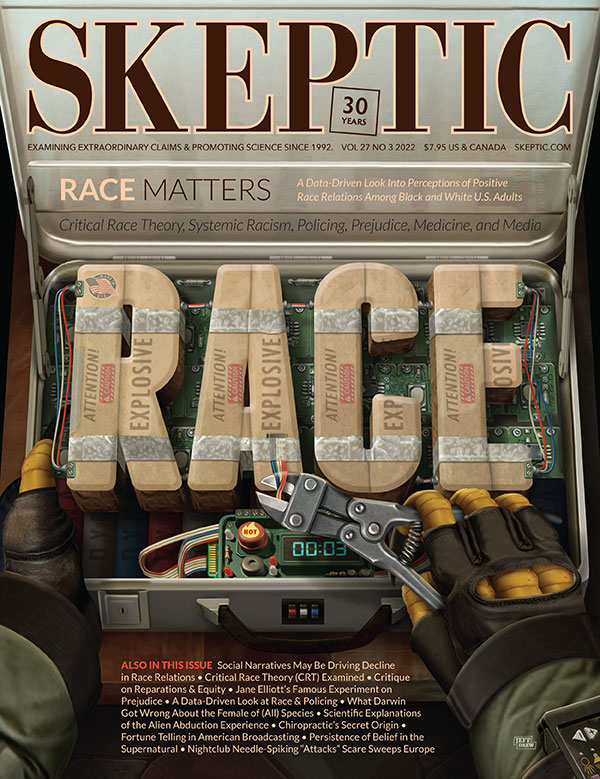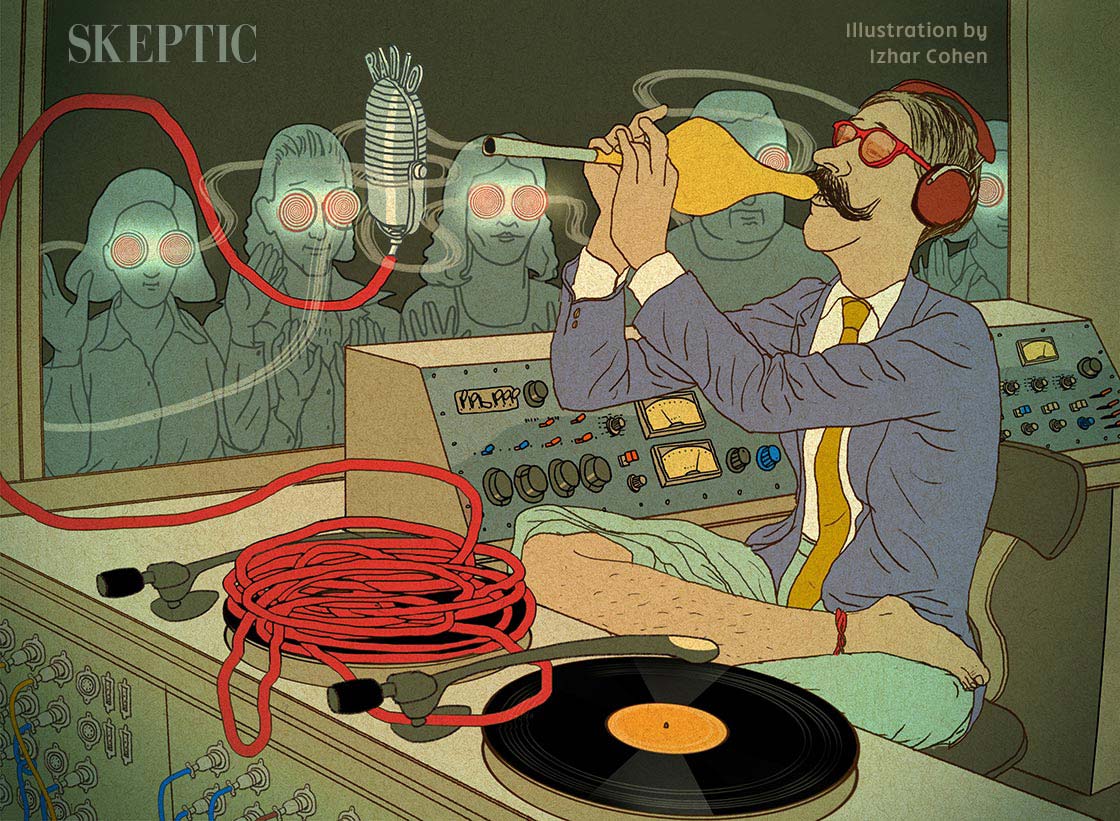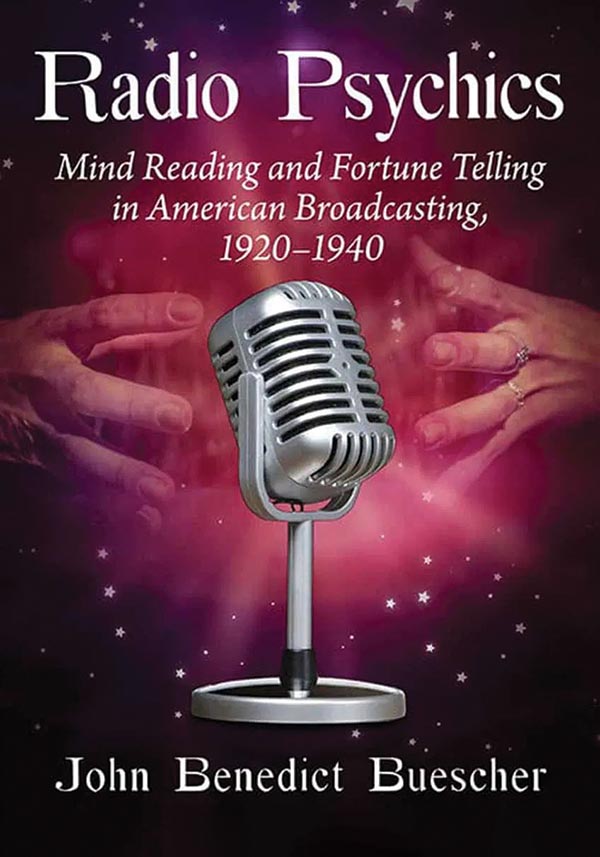“A broadcasting station can’t … [explain] that the mystics are only entertainers … so long as the listener sends in money and problems in good faith.”1
How successful were psychics on early network radio? How sincere were they? These are the main questions asked in the groundbreaking new book Radio Psychics: Mind Reading and Fortune Telling in American Broadcasting, 1920–1940. The author, John Benedict Buescher, former chief of the Tibetan Broadcast Service of the Voice of America, has authored articles on radio broadcasting to Tibet and books on the history of Buddhism and on the history of 19th century American spiritualism. Buescher details the careers of spiritual seekers, entertainers, and hucksters who were popular in the early decades of U.S. radio.
Some “radio psychics” began as seemingly sincere spiritual believers, sometimes performing relatively traditional congregational work; others became so. Especially in the 1920s, some radio psychics were described as magicians or mentalists, as having a “Radio Mind”, and some were billed as Princesses or Rajah; Mystic, Wizard or Fakir; astrologer or spiritualist or Hypnotist. Some used more than one of these billings, successively or even concurrently. Many incorporated astrology or billed themselves as having gained extraordinary knowledge in India, Egypt, or both, and sometimes wore turbans. Some were vaudeville entertainers who read minds on stage and used the radio for publicity. A few psychic claimants earned fortunes from radio programs, especially after transitioning to giving advice.
Whether reading minds, consulting spirits on the radio, or conducting what they called experiments, many radio psychics ran afoul of the same fortune telling laws or charges of obtaining money under false pretenses as faced by live psychics. Several of these colorful characters were sued, fined, arrested, or jailed, sometimes for reasons unrelated to their paranormal claims.
In later years, usually with similar offerings but more traditional attire, many transitioned to calling themselves “doctor” or “psychologist” (both terms being less respected than today). All made some sort of paranormal or extraordinary claim about how they worked. Many were cynical, some were sincere, and more than one may also have transitioned from knowing they were fakes to believing themselves truly psychic. Those who were especially skilled, or more ethically challenged, were flooded with mail, often including dollar bills and, perhaps more importantly to them, the basic building blocks of a mailing list.
Buescher’s introductory chapter is a rich and valuable narrative of the diverse cultural trends that fed the public reception of radio psychics of the 1920s and 1930s. These include 19th century upstart religious movements (especially séance-based spiritualism), astrologers and psychics featured on the fringes of carnivals, fairs, and dime museums; and the popular stage magic feat of “second sight” mind reading, in which a psychic blindfolded on stage would divine the identity of items shown to the performer roaming through the audience.
Lectures/demonstrations of mesmerism and hypnotism are surprisingly relevant because they foreshadowed the radio psychics blurring of the lines between entertainment, self-improvement, science, and fraud. Telegraphy and early radio technology were often thought of as magical phenomena. This both made psychic communication seem more plausible, and gave performers, scientists, and newspapermen a frequently used metaphor. Although the format of most of the balance of Radio Psychics is an overlapping, loosely chronological series of biographies, the introduction foreshadows the rest of the book’s style in being twice as detailed as it needs to be to make its fascinating points. Numerous small photographs significantly enhance the dense text. It is (thankfully) indexed, and the extensive endnotes are a valuable resource given how much new information the book provides.
Who was the first psychic to read a mind on the radio? Most of the various claimants saw occasional radio appearances as a way to publicize their vaudeville stage shows of theatrical mind reading. Often these early publicity stunts were in conjunction with then more widely available newspaper “Question and Answer” articles. While their credibility hinged on the public at least partially believing that the performer was truly psychic, these performers, most active in the 1920s, such as Hope Eden and Julius Zancig, were generally not accused of fraud, and were known among their theatrical peers as merely being entertainers. What fame they had was usually from their stage work.
While individual specialties and personalities varied, many of the radio psychics, even in the later years of their peak popularity, remained rooted as showmen. Many of them staged publicity stunts (sometimes billed as experiments) such as hypnotic “sleeps” in store windows or, more frequently, driving a car while blindfolded. Of the dozens of radio psychics (with minor ones treated in the appendix), Buescher focuses on about 25, giving an average of half a chapter to each. Of these, those relatively famous or prosperous include Leona LaMar, Gene Dennis, Princess Yvonne, Dr. Korda RaMayne, Ralph Richards, Koran, and Rajah Raboid. The latest performer Buescher features is the mid-20th century radio and TV mind reader Joseph Dunninger.
The broadcast landscape evolved rapidly and dramatically between 1920 and 1940. Stations went from amateur and isolated to professional and networked; listenership grew exponentially, and regulation went from non-existent to stringent as radio evolved into a mass medium by the 1930s.
With a wider audience, ethical challenges mounted. Simultaneously, more and more psychics wanted airtime, and for some it became their focus. Sometimes live shows also led to private client consultations, which could be especially profitable, but more likely unethical. A common dodge was to sell a booklet at a live theater appearance that included a coupon that could be mailed in for “free” advice, with reminders of this on the radio. As time passed, many radio psychics began to focus on giving advice on finance, health, and even finding lost children.
Buescher draws an uncommonly vivid verbal portrait of one of the most nefarious radio psychics taking a huge sack of mail to a side road, slitting open the envelopes one by one, removing any money they contained, and tossing the unread letter into a ravine. He was Ralph Richards, who other radio psychics accused of spoiling the racket by his extreme callousness. Perhaps not coincidentally, the incident took place in 1932, the year the Federal Radio Commission cracked down on radio fortune telling. It was more common for radio psychics to respond with a “heartfelt” personal response, which, in reality, was a form letter prepared by secretaries. Charges of fortune telling or mail fraud often resulted.
Some radio psychics were more sincere and had minimal connection to stage performance, though all did at least some work that could be seen as related to mind reading. Alma started a successful astrology magazine; Ethel Duncan was a minister with a reputation for charity. A few of the people profiled by Buescher stand out for other reasons: although many performers cashed in on “Ladies Only” performances, Signa Serene specialized in this intimate advice format. Buescher did genealogy research on Princess Wahletka, whose otherwise unremarkable act became famous from her false claim to be Cherokee, and fakir Hamid Bey, famous in part for his repeated performance of being buried alive, is also shown to be an ethnic fraud. Others went from psychic work to allied fields: Norman Baker harangued crowds and made a fortune as he claimed he could cure cancer, and successful radio psychic Koran and his astrologer wife Rose Dawn later used alleged Mayan teachings to start a membership-based spiritual society which outlasted the couple by decades. Skeptic readers may be especially intrigued by Maurice “Radio Wizard” Francill, who claimed that electronics facilitated his psychic powers. Of course, he rarely allowed his contraptions to be examined. Buescher conducted the necessary research to document that Francill, in fact, held no patents and had no citations in technical journals.
Most of the above, and much more, is either new information from primary sources, or seems so for being put together for the first time from diverse secondary sources. Radio Psychics is over 400 pages long, with small type and detailed footnotes (in even smaller type) that refer the reader to multiple academic journals (including those on medicine, folklore, and psychology) and primary sources, such as Federal Radio Commission files, legal records, and scarce advertising material. The high level of detail given in the text is a double-edged sword. If a performer appeared on the radio even once, not only is their whole career discussed, the rest of their life (and even their family!) is as well. As grateful as I am for the wealth of new information on theatrical mind readers on stage, Buescher’s largely nominal radio psychics focus forces him to ignore the few prominent psychic entertainers or seers who did not appear on the radio, including the most famous and successful vaudeville mind reader, Claude Alexander Conlin, known professionally as Alexander, the Man Who Knows.
It’s not only because of its length that this book could have used a good editor. Although Buescher’s sentence structure is fine, his prose can be difficult to read, with crucial information often appearing in the midst of ancillary material, such as that psychic performer Mel Roy was a household name, or the National Association of Broadcasters statement against fortune tellers on the radio. Even the regulatory changes that drove many radio mentalists off the air, or the resulting trend of psychics (and medical quacks) fleeing to broadcast back to the United States from Mexico, are scattered almost randomly among the entries on one or more of the performers affected by them, and even then, it is not highlighted.

This article appeared in Skeptic magazine 27.3
Buy print edition
Buy digital edition
Subscribe to print edition
Subscribe to digital edition
Download our app
Radio Psychics is thus a bit of a mixed bag. The subject of psychics on the radio in its heyday, and the immediate effects of this, could have made for a useful and informative narrative that was half the length. Although Radio Psychics is already the most thorough book yet published on stage psychics in the U.S., better editing, and the addition of only a chapter or two would have turned Radio Psychics into a book of the same length which would be a near complete narrative about psychic performers in the U.S. within its time frame. As it is, it is neither. In a few cases, mention of the psychic’s appearance on radio is difficult to find in the chapter!
For all its dramatic personalities, Radio Psychics is tedious and very difficult to read. However, if you forgive the unfortunate phrasing, and once the text is disentangled, the stories can be fascinating, and raise questions about the fuzzy line between performance and religion that remain relevant today. ![]()
About the Author
Michelle Ainsworth holds an MA in History and she is currently researching the cultural history of stage magic in the United States. She is a humanist and lives in New York City.
References
- Buescher, J.B. (2021). Radio Psychics: Mind Reading and Fortune Yelling in American Broadcasting, 1920–1940 (p. 171). McFarland and Company.
This article was published on December 24, 2022.
















